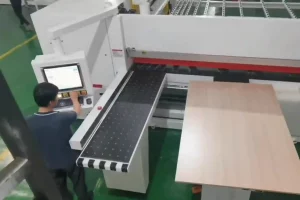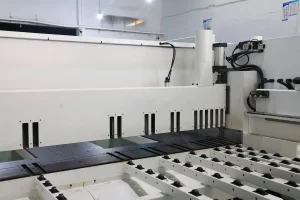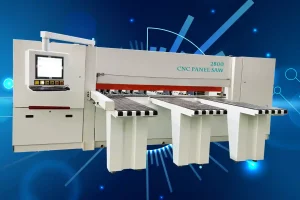
How to Choose the Perfect High-Speed Computerized Panel Saw
Introduction: The Rise of the High-Speed Computerized Panel Saw
In the evolving landscape of manufacturing, staying ahead requires adopting tools that boost efficiency and precision. Among these, the high-speed computerized panel saw stands out as a cornerstone for businesses seeking unparalleled productivity. Whether you are a small furniture maker or a large-scale manufacturer, selecting the right panel saw can profoundly impact your operational success.
A high-speed computerized panel saw offers the dual advantage of speed and precision, enabling businesses to handle large volumes of materials with ease. However, the plethora of options in the market can make the selection process overwhelming. By focusing on four key factors—cutting capacity, speed, cost, and safety—you can identify the ideal machine tailored to your needs.
Cutting Capacity: The Foundation of Your Selection
When evaluating high-speed computerized panel saws, the cutting capacity is a critical parameter to consider. It defines the maximum thickness and size of materials the machine can handle, ensuring compatibility with your production requirements.
For manufacturers working primarily with thinner materials such as MDF or plywood, a machine with modest cutting capacity can suffice. However, for industries handling denser or larger materials like composite panels and hardwoods, selecting a saw with a robust cutting capacity is non-negotiable. A mismatch in capacity can lead to inefficiencies and increased wear on the machine.
Understanding the materials you commonly use will also help optimize workflow, reduce waste, and prevent unnecessary machine stress. As you narrow down your options, keep in mind the type of materials you may work with in the future, ensuring the saw remains adaptable to changing demands.
Speed: The Game-Changer for High-Volume Outputs by High-Speed Computerized Panel Saw
Speed is often the decisive factor for businesses producing at scale. A high-speed computerized panel saw not only accelerates cutting operations but also ensures consistent quality across high volumes.
Machines designed for speed are equipped with advanced motors and optimized algorithms, enabling them to handle repetitive tasks with minimal downtime. However, it’s important to strike a balance. If your operations demand intricate cuts or designs, speed alone might not suffice—precision should take precedence.
The right machine will align with your production goals, offering the flexibility to handle both rapid throughput and detailed craftsmanship. Evaluate the technical specifications to ensure the saw’s speed meets your expectations without compromising on the finish quality.
Cost: Balancing Investment with Value
Cost is an undeniable factor in any machinery purchase, and high-speed computerized panel saws are no exception. While the upfront investment can be substantial, the long-term value these machines bring often justifies the expense.
Cheaper alternatives may seem appealing initially, but they often lack the durability, precision, and advanced features of premium models. Over time, these compromises can result in higher operational costs due to maintenance, repairs, and inefficiencies.
When budgeting, consider not only the purchase price but also the total cost of ownership. Factor in energy consumption, regular maintenance, and potential downtime. Opting for a high-quality saw with reliable manufacturer support can significantly reduce long-term expenses, ensuring smoother operations and higher profitability.
Safety: Prioritizing Worker Well-Being by High-Speed Computerized Panel Saw
Safety should always take center stage when choosing a high-speed computerized panel saw. These powerful machines, if not properly equipped, can pose significant risks to operators. Modern panel saws come with a suite of safety features designed to mitigate these hazards.
Look for machines with automatic blade guards, which shield the blade when it’s not actively cutting. Emergency stop mechanisms and intuitive control panels are other essential features that ensure swift action during unexpected situations. Ergonomic designs also play a vital role, reducing strain on operators and enhancing overall workplace safety.
By prioritizing safety in your selection, you not only protect your workforce but also foster a culture of responsibility and care, ultimately improving morale and productivity.
Crafting the Ideal Manufacturing Solution
Choosing the right high-speed computerized panel saw is more than just a purchase—it’s an investment in your business’s future. The perfect machine enhances productivity, ensures accuracy, and promotes safety while offering long-term cost efficiency.
By carefully evaluating cutting capacity, speed, cost, and safety, you can identify a saw that aligns seamlessly with your business goals. Whether you’re scaling up operations or refining processes, a high-quality panel saw equips you with the capabilities needed to stay ahead in the competitive manufacturing landscape.
Every detail matters, from the materials you process to the safety of your operators. A thoughtful approach to selecting a high-speed computerized panel saw ensures not only operational excellence but also the sustainability of your business practices.
Summary
This article guides manufacturers through the process of selecting the ideal high-speed computerized panel saw. By focusing on four essential factors—cutting capacity, speed, cost, and safety—it offers actionable insights to help businesses optimize efficiency and precision in their operations. High-speed computerized panel saws provide unmatched productivity and versatility, making them indispensable in the modern manufacturing industry.
FAQ
1. What is a high-speed computerized panel saw, and why is it important?
A high-speed computerized panel saw is an advanced cutting machine designed for precision and efficiency in processing various materials. It is crucial for industries aiming to enhance productivity, reduce waste, and maintain consistent quality in their operations.
2. How do I determine the right cutting capacity for my business needs?
Evaluate the size and thickness of the materials you frequently work with. Choose a saw with sufficient cutting capacity to handle your current and potential future requirements.
3. Is speed more important than precision when selecting a panel saw?
It depends on your production needs. For high-volume outputs, speed is essential. However, if your projects involve intricate designs, precision should take precedence over speed.
4. Are high-speed computerized panel saws expensive to maintain?
While they require an initial investment, high-quality models often feature durable components and efficient energy usage, reducing maintenance costs over time. Proper care and adherence to manufacturer guidelines can further minimize expenses.
5. What safety features should I look for in a panel saw?
Key safety features include automatic blade guards, emergency stop systems, and ergonomic controls. These elements protect operators and enhance overall workplace safety.



















